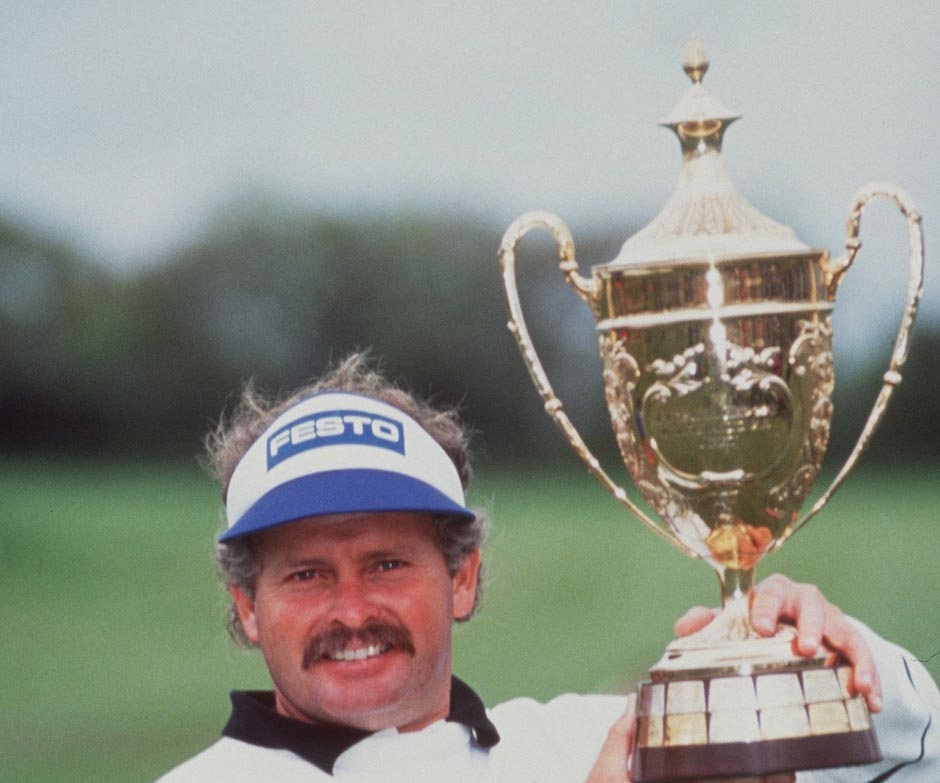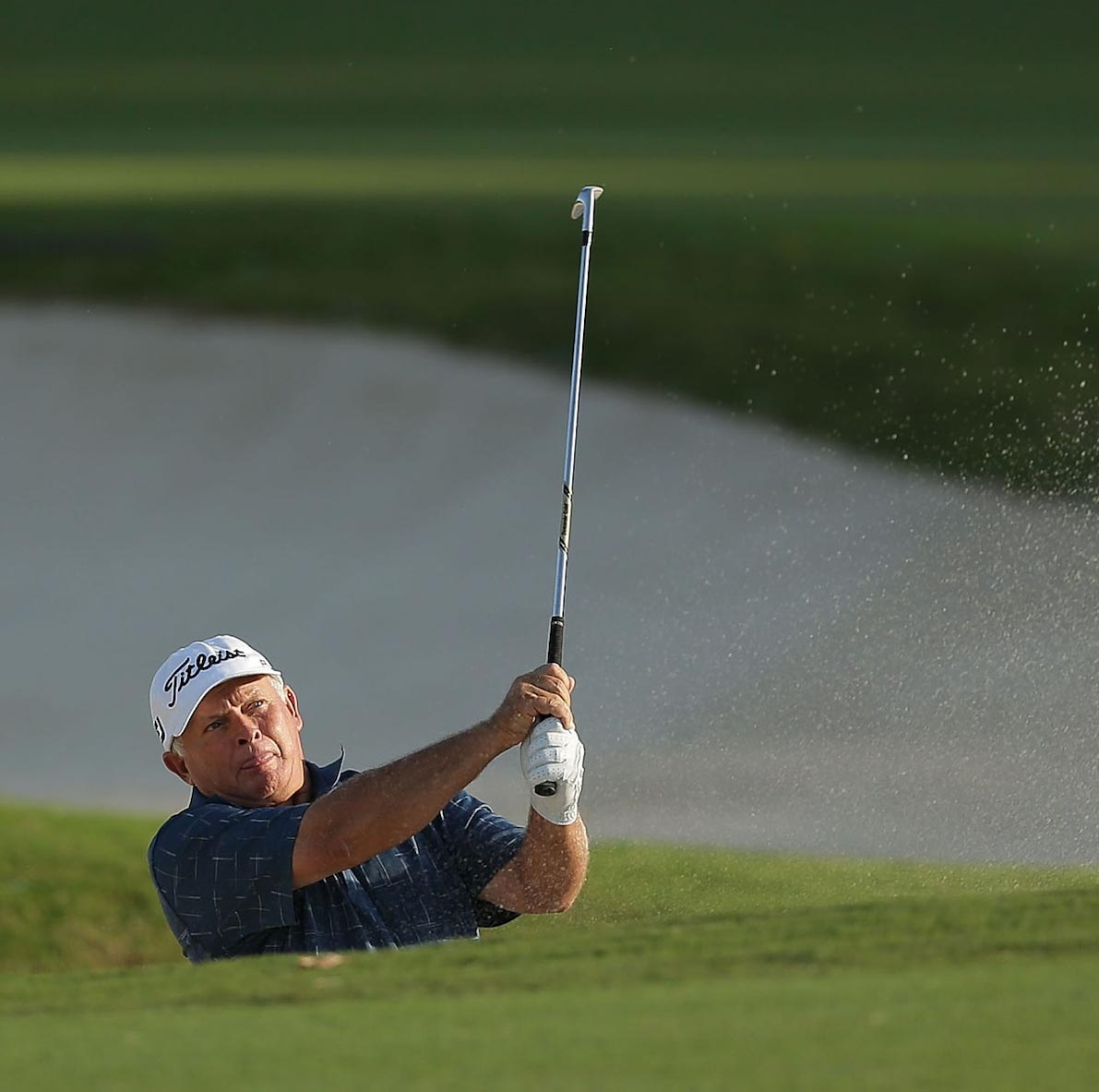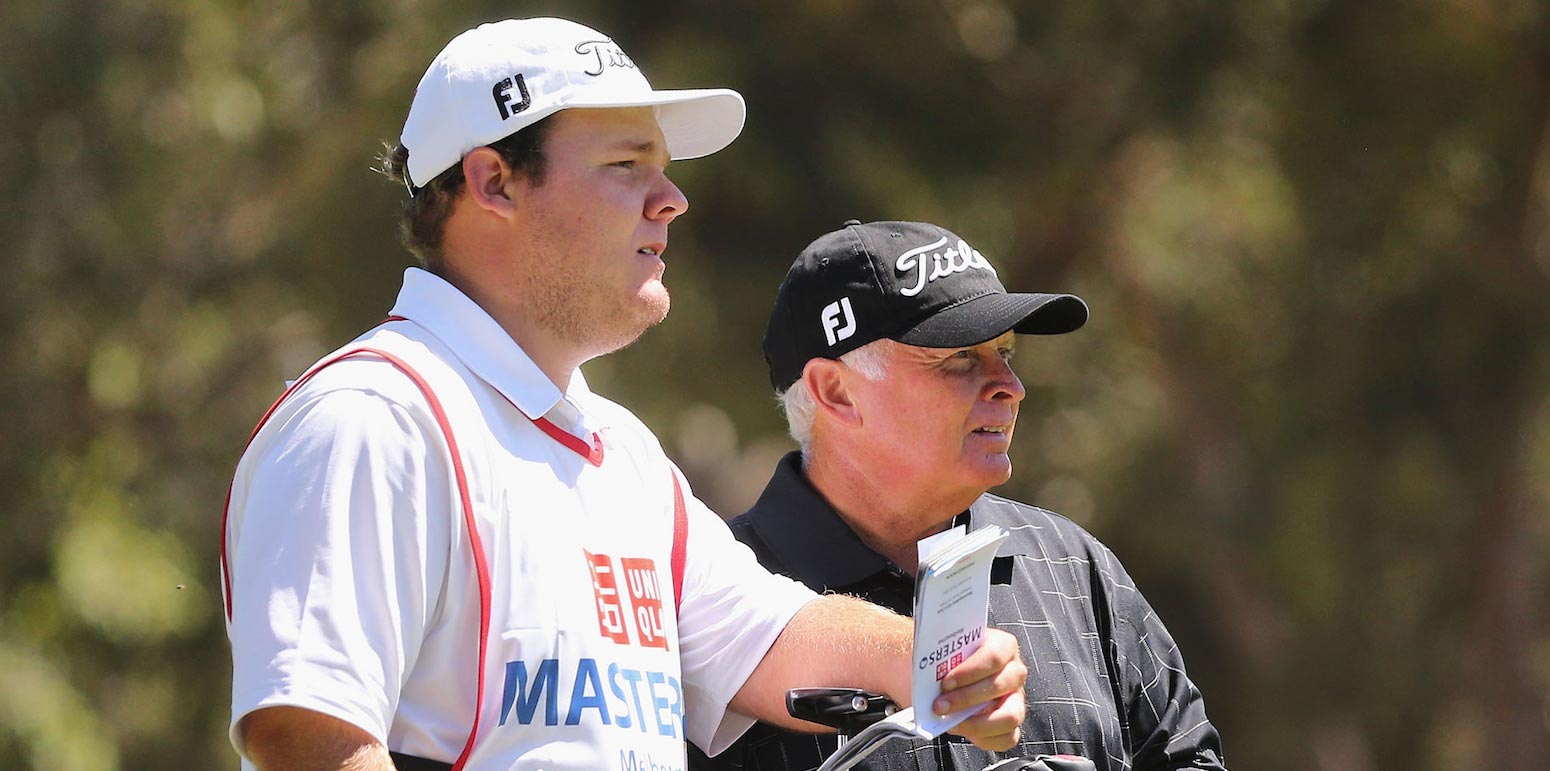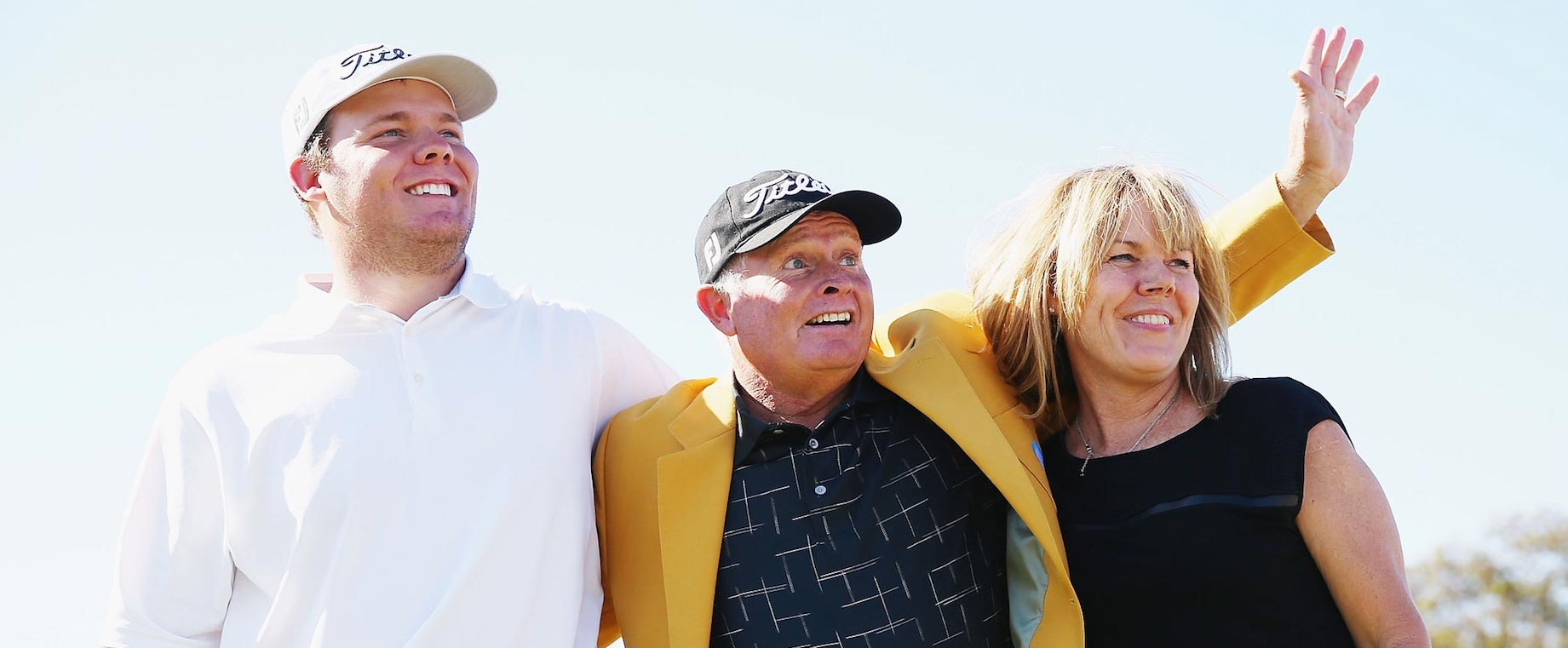Australian Golf Digest was in its infancy when a 19-year-old by the name of Peter Senior recorded his first professional victory in 1979. It would mark the start of five decades of success.
It wasn’t the launch of a golf magazine 50 years ago that convinced Peter Senior to pick up a club. An 11-year-old living in Singapore when Australian Golf Digest first hit the newsstands, Senior’s inspiration came 12 months later and happened a lot closer to home.
Sport abounds with tales of siblings driving each other to the upper echelons of their chosen pursuits and the junior Senior was no different. Older brother Jeff won the Singapore Open Amateur in 1971 and then when the family returned to Queensland in 1972 – Bert Senior served in the Australian Army – Jeff enjoyed further success, taking out the Australian Schoolboys title.
“I thought, This game must be pretty easy. That’s when I started,” Senior recalls. “Jeff hated me playing. He used to put me down a lot. I was on a 42 handicap to begin with when I was 14 and I was playing off 3 in 12 months. I just loved the game.”
Such was Senior’s infatuation, he was ultimately expelled from school at 16 because – unbeknown to his parents – he chose to spend his days at the golf course instead of the classroom. His premature end to schooling was a split decision within the family home.
“My mum was so upset but my dad was fine with it because he knew what I wanted to be,” Senior remembers of his school expulsion. “We never discussed a traineeship. We were never flush with money and the last thing I wanted to do was ask Dad and Mum for money. I got a night job contract cleaning with a friend who was a member at Keperra Golf Club. I worked from 6pm until midnight and played golf all day.”
He joined the professional ranks in the latter of months of 1978 and in February 1979 won the Dunhill South Australian Open in a playoff. Here, in his own words, Peter Senior recalls the highs and lows of five decades of tournament golf.
– Tony Webeck

1970-1979: Transitioning to life on tour
Turning professional was a little different in those days. Wayne Grady was the first guy to turn pro from amateur without going through any qualification. Then they started to bring in some things like: if you were in the state amateur team, you were good enough to turn pro. Wayne Grady paved the way for most of the guys who were good players to turn pro straight from the amateur ranks. I felt that I was wasting time playing as an amateur. I wanted to be a golf pro and I decided to turn pro in 1978.
I was 19 and didn’t have enough to go touring at that stage so I borrowed a bit of money off Dad and drove down to the PGA and the Aussie Open. I thought at 19 that if I put in a reasonable effort and made the cut in both of my first couple of events before the end of the year that I had a good chance of doing some good in this game. In February I won the South Australian Open and won $5,000. I paid Dad back and I kept the rest in case I needed it to go to future tournaments.
I played my first British Open when I was 19. They had a sportswriter’s award for the best player under 25 and they received a trip to the British Open. I got to play in the British Open at Lytham & St Annes at 19. Wow. It was a huge experience. I went by myself and got into a few other tournaments via the Monday qualifying. I joined the European Tour and played my first few events over there and then played the British Open at Lytham. I didn’t play another British Open after that until ’84.

1980-1989: Euro-tripping and the Triple Crown
Greg Norman was the first one of any note to go to Europe. Bob Shearer was there also and they thought that if you wanted to learn how to play golf you had to go to Europe. We learnt our trade there because the US tour wasn’t as big as it is these days. Now all our great young players go straight to the US tour.
Europe was more of a world tour. They had a lot of South Africans and the tour had some great Swedish players: Mats Lanner, Ove Sellberg – they had four or five really, really good players. It was nothing to have four nationalities going to dinner, so they accepted you pretty readily. That’s what I liked about Europe. It didn’t matter who you were, you got on with everybody. The Australians were liked because they’re pretty happy-go-lucky guys, easy to get along with and fitted in pretty well.
My first real year there was 1985 and I had my wife June caddie for me. We won the PLM Open in Malmo in Sweden in 1986 and that was a great kick-along. I felt like I was suited to play there.
I changed to the broomstick putter in early July 1989. A good friend of mine, Sam Torrance, was using one when I played with him at the Italian Open and it was the first time I’d ever seen the long putter. He putted really well with it. We were going to play the British Masters at Woburn the next week and I’d been putting very ordinary. I got talking to Sam on the putting green and asked whether he had a spare one that I could try. He had the prototype in the car so I ended up using it that week. I practised a few hours with it before the tournament and finished third in that event. It stuck in the bag and when I brought it home I’d started to play very well from tee to green. I didn’t miss many short putts, which is probably the key to any good golf score. I went on a tear with it for about four or five years, which was great.
In 1989, I won the Triple Crown and it was the most incredible three weeks of golf in my life. After I won the Australian PGA at Riverside Oaks, I felt that I was competitive in every tournament I played. I gained so much confidence from it that when I teed it up in the Australian Open at Kingston Heath I played so well. I played with Bob Shearer the first two days and I shot 66-66 in windy conditions. Everyone was talking about the broomstick putter and what-have-you, but Bob knew I missed maybe one green over the first 36 holes. From tee to green it was unbelievable.
I ended up winning the Australian Open by seven shots in a class field with Faldo, Seve, Norman, Curtis Strange and Mark Calcavecchia. Those were the gun guys of that time and to win that sort of tournament by seven shots… The next week we went to Royal Melbourne for the Johnnie Walker Classic and I won by five shots. It was a period when I felt that I could not hit a bad shot. Three weeks in a row when I could not hit a bad shot and I’ve never had that feeling again. You have it for a day or two but I’ve never had it for that extended period ever again.
You heard rumours that people thought I was cheating using the long putter. I played with Norman a couple of times and he got to know that it wasn’t really the putter that was doing the damage. It was from tee to green. The tournaments that I won in 1989, I never broke 30 putts in any round. Everybody said that I putted great but if you looked at the record book, I never broke 30 putts in any round. That’s how well I hit it from tee to green. I know I putted well, but I didn’t putt great.

1990-1999: Majors and misery
I never really performed in any of the Majors. My best result other than the tie for fourth at Royal St George’s in ’93 was a sixth at Lytham in ’88. I played steady at St George’s but then towards the end – 14, 15, 16 – I birdied all three to get level at the top with two holes to play. I hit a 4-iron into about 10 feet at 17 and figured that if I could hole that and par the last that I would have a good chance of winning. I ended up missing that one and hit it in the rough on the last and made bogey. Norman ended up birdieing the same holes coming in and going on to win. It’s probably one of the highlights, to actually be in contention in one of those events.
I started to play in Japan in the early ’90s and it was more a family decision. My eldest had just finished pre-school and we were still living in London and I didn’t want them to go in and out of schools. I’d go up to Japan for two weeks and come home for two weeks so that it didn’t disrupt their school. It worked all right for a little while but it was a pain in the backside.
I enjoyed playing, the courses were good but the competition wasn’t great in those days so finishing in the top 10 was really easy. To win you still had to play great but you were disappointed if you didn’t finish in the top 10.
In 1997 I was ready to give the game away. I was playing so badly that I really didn’t know what I was going to do. I played the Canon Challenge at Terrey Hills and actually won the tournament but I was so disgusted with myself for the way I played. I chipped and putted like a genius. The last day I played with Peter Lonard and Pete never missed a shot for the whole 18 holes and never made a putt. I was all over the place. I was in bushes here, bushes there and I ended up winning in a playoff.
Gary Edwin came up to me after the event to congratulate me and I said, “Thanks Gaz, but I really think I’m going to give the game away.” There was no enjoyment. Every time I stood over the ball I thought I was going to miss it. Gary likes to help anybody and asked whether I wanted to fix it. I told him I’d give anything to fix it and get the enjoyment back in the game again. I joined Gary Edwin and 12 months later I finished second at the Aussie Open.

2000-2009: Calling Australia home
I made a really big decision when I turned 40 in 1999. Bob Shearer told me that the only thing he regretted in his life was not seeing his kids grow up while he was playing in America. I said to June that we could play enough in Australia. I never went overseas – I might have played the British Open – but I didn’t spend the whole year away from home. It was great. I watched my kids grow up, I watched Mitch play footy, the girls did gymnastics and when I was 48 I told Gary that I wanted to have a go at the Champions Tour.
I hadn’t had a win since ’97 when I won the PGA at Coolum in 2003. The golf course suited me because you don’t have to be a long hitter. If it had been at another course it may have been a different result. You have to be straight and you have to be precise at Coolum.
Coming down the straight, I was three in front with two holes to play and I three-putted 17 and 18. Eighteen was one of those holes where you could make 6 so easily. I hit a good drive and for my second shot the wind was into and off the right and you don’t want to go in the water. I hit it on the far-right corner of the green and three-putted to win by one from Rod Pampling. It was just another result to propel me to think that I’ve still got the game to win, even though I was past 40.
Gary and I put a plan together and we worked hard for 12 months. I went over to the Champions Tour qualifying at the end of 2009 and won the qualifying tournament by three shots.

2010-2019: Senior by name, senior by nature
When I qualified for the Champions Tour, my daughter Krystlle was working at the childcare centre here at Hope Island, my daughter Jasmine had just finished school and Mitch was in Grade 10. I just thought it was a great opportunity to take the whole family over to the US for the first year. I gave Mitch the ultimatum: he either goes to boarding school or he comes and caddies for me on the Champions Tour. It wasn’t a real hard decision for him because Mitch hated school.
It’s strange going to a new place. I didn’t want to make any waves so I kept to myself and was as pleasant as I could be to everybody and they accepted me pretty well. We rented a house in Florida for the first year because we weren’t exactly sure what was going to go on but the kids came to every single tournament. The girls went off and did things in the different places, Mitch was on the course with me and then they followed me around for the three days of the tournament. We’d play three weeks and then have two weeks off so in that two-week period we’d go on cruises or go to Alaska. We went to the goldfields for two weeks and that was awesome. We caught the cruise from Anchorage down to Vancouver. It was the best family year I’ve ever had.
My goal – and I thought I could do it – was to win on the Champions Tour. I lost a few playoffs and in that time I won the Australian PGA and the Australian Open, but I couldn’t win on the Champions Tour.
I had my chances over there. I birdied the 71st hole when I played with Tom Lehman at The Tradition and I nearly birdied 18, which was a difficult hole. Tom holed a 10-footer at the first playoff hole for par and I missed mine from a similar distance. Corey Pavin, the chip that he hit on 14 out of that hole at the back of the green at the Allianz Championship… Mark Calcavecchia and I were still shaking our heads three holes later. Anybody else would have made 6. The other one was four guys in a playoff at a new tournament in Korea that Jay Don Blake won. I had a chance from 12 feet on the first playoff hole, hit a great putt and it did the horseshoe. Two holes later I was out.
We had so much rain the week of the 2010 PGA at Coolum that we went to a Monday finish. I played with a couple of young guys from America the last day and we finally had it called off after about 10 holes on the Sunday.
I was one behind Geoff Ogilvy playing the last hole and had to make birdie to get into a playoff. I hit a very good drive – 18 is always an intimidating drive with water on the left and bunkers on the right. I hit a good iron shot into about 15 feet and holed it for birdie to get into the playoff.
No one is expecting me to win because Geoff had won the US Open a few years before that. There was no pressure on me because if I finished second nobody would have said anything. We parred the first playoff hole and then went back for the second playoff hole. The three drives – the 72nd hole and the two drives I hit in the playoff – I could have thrown a blanket over where they finished. Geoff hit it into the far-right corner of the green and three-putted the second playoff hole. You don’t expect to win those sorts of tournaments past 50 and it was just a blessing.
Winning the Australian Open at The Lakes in 2012 with Mitch on the bag is the highlight of my life, as far as the game of golf goes. Having your son on the bag, winning a tournament like that against pretty good players… Justin Rose and all those guys were there. I know the conditions were pretty hard but on those sorts of days, if you’re on your game you can still shoot a score. I just had a day when things went right for me.
We’d checked out of the motel on the Sunday morning and were going to fly back to Queensland but because the tournament finished so late my manager, David Rollo, organised a suite at Star City Casino. They put a huge bottle of champagne and food on for me free of charge. I had the whole family there and it was a great night.
Mitch was actually a really good caddie. He took my mind off the golf when I was getting troubled somehow. I’d hit it in a fairway trap and not hit a very good shot out. I was a little hot walking down the fairway and Mitch would come up and say, “Did you see how good I raked that bunker back there, Dad?” It would ease the tension a little bit. I’d three-putt a green and as we’re walking off he’d say, “How many of these girls do you reckon are watching me and not you?” Just something to break the ice, and he was very, very good at it.
I was 56 when I won the Masters at Huntingdale in 2015. That’s always been a course that has really suited me because I’m a really straight driver of the golf ball. I was hitting driver where guys were hitting irons. At No.8 I’d drive it just short of the bunker and I’d have a 50-yard pitch whereas other guys would be laying back.
I made par at 15 and 16 on the Sunday and that was the first time I could have a look at the leaderboard. When I look up I see I’m two shots in front. Honestly, on the next tee I crapped myself. I’ve never had that feeling coming down the stretch of a golf tournament. I always hit driver at 17 and I said to Mitch, “Give us the 3-wood,” and I hit it straight in the bush on the right where everybody goes. I chipped it out, hit a good shot in and made bogey and then hit a good bunker shot on the last to make par and win by two.
Mitchell was happier that time than winning the Australian Open. He was beside himself. He had the gold jacket on. It just made me happy that he was happy.
All tournament wins have their significance but winning a full-fledged tournament with a good field after 50 is a big accomplishment for any guy on the Legends or Champions Tour. To win at that late stage against good fields, you’ve always got to feel that you’ve done a good job.
I feel that I’m a golfer. It’s a score on the board. I’ve always thought that way because I’ve never been the longest off the tee but I’ve been one of the straightest. The young guys hit it 50 metres past me but quite often they don’t find a few of them. If I can put a score on the board they’ve got to beat it. That’s how I’ve always played my golf.
– written with Tony Webeck
• • •
Five decades of dominance
1970s: Dunhill South Australian Open (1979)
1980s: Stefan Queensland Open, Honeywell Classic, New South Wales PGA (1984); West Australia PGA Championship (1985); PLM Open (1986); Johnnie Walker Monte Carlo Open, U-Bix Classic, Rich River Classic, Queensland PGA Championship, New South Wales PGA, Victorian PGA Championship (1987); Australian PGA Championship, Australian Open, Johnnie Walker Classic, New South Wales PGA (1989)
1990s: Panasonic European Open (1990); Pyramid Australian Masters, Johnnie Walker Classic (1991); Benson & Hedges International Open, Bridgestone ASO Open (1992); The Crowns, Heineken Classic (1993); Canon Challenge (1994); Dunlop Open, Australian Masters (1995); Canon Challenge, Greg Norman Holden Classic (1996); Canon Challenge (1997).
2000s: Australian PGA Championship (2003); Australian PGA Seniors Championship (2009)
2010s: Australian PGA Championship, Handa Australian Senior Open (2010); Emirates Australian Open (2012); Uniqlo Masters (2015)




